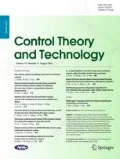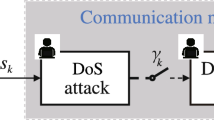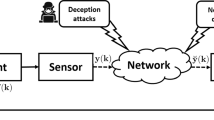Abstract
With the development of wireless communication technology, cyber physical systems are applied in various fields such as industrial production and infrastructure, where lots of information exchange brings cyber security threats to the systems. From the perspective of system identification with binary-valued observations, we study the optimal attack problem when the system is subject to both denial of service attacks and data tampering attacks. The packet loss rate and the data tampering rate caused by the attack is given, and the estimation error is derived. Then the optimal attack strategy to maximize the identification error with the least energy is described as a min–max optimization problem with constraints. The explicit expression of the optimal attack strategy is obtained. Simulation examples are presented to verify the effectiveness of the main conclusions.





Similar content being viewed by others
References
Rajkumar, R., Lee, I., Sha, L., & Stankovic, J. (2010). Cyber-physical systems: the next computing revolution. In Proceedings of the 47th design automation conference (pp. 731–736), Anaheim, California.
Monostori, L., Kádár, B., Bauernhansl, T., Kondoh, S., Kumara, S., Reinhart, G., et al. (2016). Cyber-physical systems in manufacturing. CIRP Annals-Manufacturing Technology, 65(2), 621–641.
Bolbot, V., Theotokatos, G., Bujorianu, L. M., Boulougouris, E., & Vassalos, D. (2019). Vulnerabilities and safety assurance methods in cyber-physical systems: a comprehensive review. Reliability Engineering & System Safety, 182, 179–193.
Guo, J., & Diao, J.-D. (2020). Prediction-based event-triggered identification of quantized input FIR systems with quantized output observations. Science China Information Sciences, 63, 112201:1-112201:12.
Ly, K., & Jin, Y. (2016). Security challenges in CPS and IoT: from end-node to the system. In Proceedings of the IEEE computer society annual symposium on VLSI (ISVLSI) (pp. 63–68), Pittsburgh, PA, USA.
Chen, J., Huang, B., Ding, F., & Gu, Y. (2018). Variational Bayesian approach for ARX systems with missing observations and varying time-delays. Automatica, 94, 194–204.
Gao, Y., Wang, L., Ren, W., Xie, F., Mo, X., Luo, X., et al. (2020). Reinforcement learning-based detection method for malware behavior in industrial control systems. Chinese Journal of Engineering, 42(4), 455–462.
Peng, L., Shi, L., Cao, X., & Sun, C. (2018). Optimal attack energy allocation against remote state estimation. IEEE Transactions on Automatic Control, 63(7), 2199–2205.
Guo, J., Wang, X. B., Xue, W. C., & Zhao, Y. L. (2021). System identification with binary-valued observations under data tampering attacks. IEEE Transactions on Automatic Control, 66(8), 3825–3832.
Su, L., & Ye, D. (2019). Observer-based output feedback H\(_\infty \) control for cyber-physical systems under randomly occurring packet dropout and periodic DoS attacks. ISA Transactions, 104, 26–35.
Lu, A. Y., & Yang, G. H. (2019). Observer-based control for cyber-physical systems under denial-of-service with a decentralized event-triggered scheme. IEEE Transactions on Cybernetics, 50(12), 4886–4895.
Sun, Y. C., & Yang, G. H. (2019). Robust event-triggered model predictive control for cyber-physical systems under denial-of-service attacks. International Journal of Robust and Nonlinear Control, 29(14), 4797–4811.
Chen, B., Ho, D. W. C., Hu, G., & Yu, L. (2017). Secure fusion estimation for bandwidth constrained cyber-physical systems under replay attacks. IEEE Transactions on Cybernetics, 48(6), 1862–1876.
Fang, C., Qi, Y., Cheng, P., & Zheng, W. X. (2020). Optimal periodic watermarking schedule for replay attack detection in cyber-physical systems. Automatica, 112, 108698.
Wang, H., Ruan, J., Zhou, B., Li, C., Wu, Q., Raza, M. Q., & Cao, G. Z. (2019). Dynamic data injection attack detection of cyber-physical power systems with uncertainties. IEEE Transactions on Industrial Informatics, 15(10), 5505–5518.
Yang, W., Zhang, Y., Chen, G., Yang, C., & Shi, L. (2019). Distributed filtering under false data injection attacks. Automatica, 102, 34–44.
Drayer, E., & Routtenberg, T. (2020). Detection of false data injection attacks in smart grids based on graph signal processing. IEEE Systems Journal, 14(2), 1886–1896.
Guo, J., Wang, L. Y., Yin, G., Zhao, Y., & Zhang, J.-F. (2015). Asymptotically efficient identification of FIR systems with quantized observations and general quantized inputs. Automatica, 57, 113–122.
Diao, J. D., Guo, J., & Sun, C. Y. (2018). Event-triggered identification of FIR systems with binary-valued output observations. Automatica, 98, 95–102.
Tan, S., Guo, J., Zhao, Y., & Zhang, J. F. (2021). Adaptive control with saturation-constrainted observations for drag-free satellites - a set-valued identification approach. Science China Information Sciences, 64(10), 202202.
Risuleo, R. S., Bottegal, G., & Hjalmarsson, H. (2020). Identification of linear models from quantized data: a midpoint-projection approach. IEEE Transactions on Automatic Control, 65(7), 2801–2813.
Pouliquen, M., Pigeon, E., Gehan, O., & Goudjil, A. (2020). Identification using binary measurements for IIR systems. IEEE Transactions on Automatic Control, 65(2), 786–793.
Li, L., Wang, F., Zhang, H., & Ren, X. (2021). A novel recursive learning estimation algorithm of Wiener systems with quantized observations. ISA Transactions, 112, 23–34.
Wang, L. Y., Yin, G. G., Zhang, J. F., & Zhao, Y. L. (2010). System identification with quantized observations. Boston: Birkhäuser.
Author information
Authors and Affiliations
Corresponding author
Additional information
This work was supported by the National Key Research and Development Program of China (2018YFA0703801) and the National Natural Science Foundation of China (62173030, 62033010)
Appendix: Proof of Lemmas
Appendix: Proof of Lemmas
Proof of Lemma 1
From (11), it is known that \(\eta (p_0,p_1,q_0,q_1)\) is increasing with respect to \(q_0\). If \(\eta (p_0,p_1,q_0,q_1)\) gets the minimum value, then we have \(q_0=0\) and
which is increasing with respect to \(p_0\). Therefore, when \(\eta (p_0,\) \(p_1,q_0,q_1)\) achieves the minimum value, there is \(p_0=0\). At this time, one can get
According to the constraints (16)–(19) and (21), it follows that
-
1)
If \((\mu _1,\mu _2,\widetilde{F},\overline{p},\overline{q},\overline{\lambda }) \in \mathcal {M}_1\), according to the conditions of the lemma, we know that \(p_1\) can be 1. In the case of \(p_1=1\), by (22) it can be seen that the constraints (16)–(19) hold, \(\forall ~0\leqslant q_1 \leqslant 1\). At this time, we have \(\eta _{\min }=0\).
-
2)
If \((\mu _1,\mu _2,\widetilde{F},\overline{p},\overline{q},\overline{\lambda }) \in \mathcal {M}_2\), we know that \(q_1\) can be 1. When \(q_1=1\), by (22) it can be seen that, for any \(p_1\) follows
$$\begin{aligned} \max \left\{ 0,\frac{\widetilde{F}-\overline{q}}{\widetilde{F}}\right\} =0\leqslant p_1 \leqslant \min \left\{ 1,\frac{\overline{p}}{\widetilde{F}},\frac{\overline{\lambda }-\mu _2\widetilde{F}}{(\mu _1-\mu _2)\widetilde{F}}\right\} , \end{aligned}$$the constraints (16)–(19) hold. At this time, we have \(\eta _{\min }=0\).
-
3)
If \((\mu _1,\mu _2,\widetilde{F},\overline{p},\overline{q},\overline{\lambda }) \in \mathcal {M}_3\), we know that \(q_1\) can be 1. The coming discussion is carried out under \(q_1=1\). While \(\mu _1<\mu _2\), by (22) it is known that, for any \(p_1\) follows
$$\begin{aligned}&\max \left\{ 0,\frac{\widetilde{F}-\overline{q}}{\widetilde{F}},\frac{\overline{\lambda }-\mu _2\widetilde{F}}{(\mu _1-\mu _2)\widetilde{F}}\right\} \\&\quad =0\leqslant p_1 \leqslant \min \left\{ 1,\frac{\overline{p}}{\widetilde{F}}\right\} =\frac{\overline{p}}{\widetilde{F}}, \end{aligned}$$the constraints (16)–(19) hold. At this time, we have \(\eta _{\min }=0\). While \(\mu _1=\mu _2\), by (22) it can be seen that, for any \(p_1\) follows
$$\begin{aligned} \max \left\{ 0,\frac{\widetilde{F}-\overline{q}}{\widetilde{F}}\right\} =0\leqslant p_1 \leqslant \min \left\{ 1,\frac{\overline{p}}{\widetilde{F}}\right\} =\frac{\overline{p}}{\widetilde{F}}, \end{aligned}$$the constraints (16)–(19) hold. At this time, we have \(\eta _{\min }=0\). Combing (1)–(3) above, the proof of Lemma 1 is completed. \(\square \)
Proof of Lemma 2
According to (11), \(\eta (p_0,p_1,q_0,q_1)\) is decreasing with respect to \(q_1\) in its domain. Therefore, if \(\eta (p_0,p_1,q_0,q_1)\) achieves the maximum value, then we have \(q_1=0\) and
which is decreasing with respect to \(p_1\). This indicates that, when \(\eta (p_0,\) \(p_1,q_0,q_1)\) gets the maximum value, there is \(p_1=0\). At this point, one can get
From the above and the constraints (16)–(19), we know that
-
1)
If \((\mu _1,\mu _2,\widetilde{F},\overline{p},\overline{q},\overline{\lambda }) \in \mathcal {M}_4\), according to the conditions of the lemma, we know that \(p_0\) can be 1. With \(p_0=1\), by (23) it can be seen that the constraints (16)–(19) hold, \(\forall ~0\leqslant q_0 \leqslant 1\). At this time, we have \(\eta _{\max }=1\).
-
2)
If \((\mu _1,\mu _2,\widetilde{F},\overline{p},\overline{q},\overline{\lambda }) \in \mathcal {M}_5\), it is known that \(q_0\) can be 1. When \(q_0=1\), from (23) one can have that the constraints (16)–(19) hold with \(\max \left\{ 0,\frac{1-\widetilde{F}-\overline{q}}{1-\widetilde{F}}\right\} =0\leqslant p_0 \leqslant \min \left\{ 1,\frac{\overline{p}}{1-\widetilde{F}},\right. \) \(\left. \frac{\overline{\lambda }-\mu _2(1-\widetilde{F})}{(\mu _1-\mu _2)(1-\widetilde{F})}\right\} .\) At this time, we have \(\eta _{\max }=1\).
-
3)
If \((\mu _1,\mu _2,\widetilde{F},\overline{p},\overline{q},\overline{\lambda }) \in \mathcal {M}_6\), we know that \(q_0\) can be 1. The next focuses on the case of \(q_0=1\). While \(\mu _1<\mu _2\), by (23) it can be seen that the constraints (16)–(19) hold with \( \max \left\{ 0,\frac{1-\widetilde{F}-\overline{q}}{1-\widetilde{F}},\frac{\overline{\lambda }-\mu _2(1-\widetilde{F})}{(\mu _1-\mu _2)(1-\widetilde{F})}\right\} =0\leqslant p_0 \leqslant \min \left\{ 1,\frac{\overline{p}}{1-\widetilde{F}}\right\} \) \(=\frac{\overline{p}}{1-\widetilde{F}}. \) At this time, we have \(\eta _{\max }=1\). While \(\mu _1=\mu _2\), by (23) it can be seen that the constraints (16)–(19) hold with \( \max \left\{ 0,\frac{1-\widetilde{F}-\overline{q}}{1-\widetilde{F}}\right\} \) \(=0\leqslant p_0 \leqslant \min \left\{ 1,\frac{\overline{p}}{1-\widetilde{F}}\right\} =\frac{\overline{p}}{1-\widetilde{F}}. \) At this time, we have \(\eta _{\max }\) \(=1\). By (1)–(3), Lemma 2 is proved.\(\square \)
Proof of Lemma 3
If \((\mu _1,\mu _2,\widetilde{F},\overline{p},\overline{q},\overline{\lambda }) \in \mathcal {M}_7\), we know that \(p_0=q_0=0\) when \(\eta \) takes the minimum value according to the proof process of Lemma 1. At this point, we have \(\lambda = \mu _1p+\mu _2q=\mu _1p_1\widetilde{F}+\mu _2q_1(1-p_1)\widetilde{F}\), which gives
From the above and (16)–(19), one can get
Substituting (24) into (11), we have \( \eta \!=\! \frac{(\mu _1-\mu _2)p_1\widetilde{F}\!+\mu _2\widetilde{F}\!-\lambda }{\mu _2(1-p_1\widetilde{F})}\!, \) which is decreasing with respect to \(\lambda \). Therefore, \(\lambda \) takes the maximum value when \(\eta \) takes the minimum value. Assume that the maximum value of \(\lambda \) is \(\lambda ^*\) under (16)–(19). It follows that \( \eta _{\min } = \frac{(\mu _1-\mu _2)p_1\widetilde{F}+\mu _2\widetilde{F}-\lambda ^*}{\mu _2(1-p_1\widetilde{F})}, \) Taking the derivative of this on \(p_1\), it can be concluded that
Therefore, while \(\mu _1-\mu _2+\mu _2\widetilde{F}-\lambda ^*\geqslant 0\), \(\eta \) is monotonically increasing with respect to \(p_1\). In this case, by (25) we have
when \(\eta \) takes the minimum value. While \(\mu _1-\mu _2+\mu _2\widetilde{F}-\lambda ^*<0\), \(\eta \) is monotonically decreasing with respect to \(p_1\). In this case, by (25) again we have
when \(\eta \) takes the minimum value.
-
1)
If \(\overline{\lambda }\geqslant \mu _1\overline{p}+\mu _2\overline{q}\), one can get \( \lambda =\mu _1p+\mu _2q\leqslant \mu _1\overline{p}+\mu _2\overline{q}=\lambda ^*\leqslant \overline{\lambda }. \) Noticing that \( \frac{\lambda ^*-\mu _2\overline{q}}{\mu _1\widetilde{F}}=\frac{\overline{p}}{\widetilde{F}} \) when \(\lambda ^*=\mu _1\overline{p}+\mu _2\overline{q}\). Therefore, if \(\eta \) takes the minimum value, by (27) we have \( p_1 = \frac{\overline{p}}{\widetilde{F}},~q_1=\frac{\overline{q}}{\widetilde{F}-\overline{p}}, \) and \( \eta _{\min }=\frac{\widetilde{F}-\overline{p}-\overline{q}}{1-\overline{p}}. \)
-
2)
If \(\max \{\mu _1\overline{p},\mu _1-\mu _2+\mu _2\widetilde{F}\}\leqslant \overline{\lambda }< \mu _1\overline{p}+\mu _2\overline{q}\), we have \( \lambda =\mu _1p+\mu _2q\leqslant \overline{\lambda }=\lambda ^*< \mu _1\overline{p}+\mu _2\overline{q}, \) that is, \(\mu _1-\mu _2+\mu _2\widetilde{F}-\lambda ^*=\mu _1-\mu _2+\mu _2\widetilde{F}-\overline{\lambda }\leqslant 0\). In consequence, if \(\eta \) takes the minimum value, from (27) we can find that \( p_1 =\frac{\overline{p}}{\widetilde{F}},~q_1 = \frac{\overline{\lambda }-\mu _1\overline{p}}{\mu _2(\widetilde{F}-\overline{p})}, \) and \( \eta _{\min }=\frac{(\mu _1-\mu _2)\overline{p}+\mu _2\widetilde{F}-\overline{\lambda }}{\mu _2(1-\overline{p})}. \)
-
3)
If \(\mu _2\overline{q} \leqslant \overline{\lambda }< \min \{\mu _1\overline{p}+\mu _2\overline{q},\mu _1-\mu _2+\mu _2\widetilde{F}\}\), then it can be seen that \( \lambda =\mu _1p+\mu _2q\leqslant \overline{\lambda }=\lambda ^*< \mu _1\overline{p}+\mu _2\overline{q}, \) that is, \(\mu _1-\mu _2+\mu _2\widetilde{F}-\lambda ^*=\mu _1-\mu _2+\mu _2\widetilde{F}-\overline{\lambda }\geqslant 0\). As a result, if \(\eta \) takes the minimum value, together with (26) we have \(p_1 =\frac{\overline{\lambda }-\mu _2\overline{q}}{\mu _1\widetilde{F}}\), \(q_1 = \frac{\mu _1\overline{q}}{\mu _1\widetilde{F}+\mu _2\overline{q}-\overline{\lambda }}, \) and \( \eta _{\min }=\frac{\mu _1\widetilde{F}+(\mu _2-\mu _1)\overline{q}-\overline{\lambda }}{\mu _1+\mu _2\overline{q}-\overline{\lambda }}. \)
-
4)
If \(\mu _1-\mu _2+\mu _2\widetilde{F}\leqslant \overline{\lambda }<\mu _1\overline{p}\), it follows \( \lambda =\mu _1p+\mu _2q\leqslant \overline{\lambda }=\lambda ^*< \mu _1\overline{p}, \) that is, \(\mu _1-\mu _2+\mu _2\widetilde{F}-\lambda ^*=\mu _1-\mu _2+\mu _2\widetilde{F}-\overline{\lambda }< 0\). Therefore, if \(\eta \) takes the minimum value, by (27) one can know \( p_1 =\frac{\overline{\lambda }}{\mu _1\widetilde{F}},~q_1 = 0, \) and \( \eta _{\min }=\frac{\mu _1\widetilde{F}-\overline{\lambda }}{\mu _1-\overline{\lambda }}. \)
-
5)
If \(\overline{\lambda }<\min \{\mu _2\overline{q},\mu _1-\mu _2+\mu _2\widetilde{F}\}\), one can get \( \lambda =\mu _1p+\mu _2q\leqslant \overline{\lambda }=\lambda ^*< \mu _2\overline{q}, \) that is, \(\mu _1-\mu _2+\mu _2\widetilde{F}-\lambda ^*=\mu _1-\mu _2+\mu _2\widetilde{F}-\overline{\lambda }\geqslant 0\). If \(\eta \) takes the minimum value, from (26) we have \( p_1 =0,~q_1 = \frac{\overline{\lambda }}{\mu _2\widetilde{F}}, \) and \( \eta _{\min }=\widetilde{F}-\frac{\overline{\lambda }}{\mu _2}. \)
Above completes the proof of Lemma 3. \(\square \)
Proof of Lemma 4
If \((\mu _1,\mu _2,\widetilde{F},\overline{p},\overline{q},\overline{\lambda }) \in \mathcal {M}_7\), we know that \(p_1=q_1=0\) when \(\eta \) takes the maximum value by the proof process of Lemma 2. Hence, it follows that \(\lambda = \mu _1p+\mu _2q=\mu _1p_0(1-\widetilde{F})+\) \(\mu _2q_0(1-p_0)(1-\widetilde{F})\), that is,
From the above and (16)–(19), one can get
Substituting (28) into (11), we get
which is increasing with respect to \(\lambda \). Therefore, \(\lambda \) takes the maximum value when \(\eta \) takes the maximum value, which implies that
where \(\lambda ^*\) is the one in the proof of Lemma 3. Taking the derivative of the above on \(p_0\) yields that
As a result, while \(\mu _1-\mu _2\widetilde{F}-\lambda ^*\geqslant 0\), it is known that \(\eta \) is monotonically decreasing with respect to \(p_0\). In this case, by (29) we have
when \(\eta \) takes the maximum value. While \(\mu _1-\mu _2\widetilde{F}-\lambda ^*<0\), \(\eta \) is monotonically increasing with respect to \(p_0\). In this case, we have
when \(\eta \) takes the maximum value.
-
1)
If \(\overline{\lambda }\geqslant \mu _1\overline{p}+\mu _2\overline{q}\), then we know \( \lambda =\mu _1p+\mu _2q\leqslant \mu _1\overline{p}+\mu _2\overline{q}=\lambda ^*\leqslant \overline{\lambda }. \) Noticing that \( \frac{\lambda ^*-\mu _2\overline{q}}{\mu _1(1-\widetilde{F})}=\frac{\overline{p}}{1-\widetilde{F}} \) when \(\lambda ^*=\mu _1\overline{p}+\mu _2\overline{q}\). Therefore, if \(\eta \) takes the maximum value, then by (31) we have \( p_0 = \frac{\overline{p}}{1-\widetilde{F}},~q_0=\frac{\overline{q}}{1-\widetilde{F}-\overline{p}}, \) and \( \eta _{\max }=\frac{\widetilde{F}+\overline{q}}{1-\overline{p}}. \)
-
2)
If \(\max \{\mu _1\overline{p},\mu _1-\mu _2\widetilde{F}\}\leqslant \overline{\lambda }< \mu _1\overline{p}+\mu _2\overline{q}\), it follows that \( \lambda =\mu _1p+\mu _2q\leqslant \overline{\lambda }=\lambda ^*< \mu _1\overline{p}+\mu _2\overline{q}, \) that is, \(\mu _1-\mu _2\widetilde{F}-\lambda ^*=\mu _1-\mu _2\widetilde{F}-\overline{\lambda }\leqslant 0\). If \(\eta \) takes the maximum value, from (31) it can be seen that \( p_0 =\frac{\overline{p}}{1-\widetilde{F}},~q_0 = \frac{\overline{\lambda }-\mu _1\overline{p}}{\mu _2(1-\widetilde{F}-\overline{p})}, \) and \( \eta _{\max }=\frac{\mu _2\widetilde{F}-\mu _1\overline{p}+\overline{\lambda }}{\mu _2(1-\overline{p})}. \)
-
3)
If \(\mu _2\overline{q} \leqslant \overline{\lambda }< \min \{\mu _1\overline{p}+\mu _2\overline{q},\mu _1-\mu _2\widetilde{F}\}\), we have \( \lambda =\mu _1p+\mu _2q\leqslant \overline{\lambda }=\lambda ^*< \mu _1\overline{p}+\mu _2\overline{q}, \) which indicates \(\mu _1-\mu _2\widetilde{F}-\lambda ^*=\mu _1-\mu _2\widetilde{F}-\overline{\lambda }\geqslant 0\). If \(\eta \) takes the maximum value, by (30) one can have \( p_0 =\frac{\overline{\lambda }-\mu _2\overline{q}}{\mu _1(1-\widetilde{F})},~q_0 = \frac{\mu _1\overline{q}}{\mu _1(1-\widetilde{F})+\mu _2\overline{q}-\overline{\lambda }}, \) and \( \eta _{\max }=\frac{\mu _1(\widetilde{F}+\overline{q})}{\mu _1+\mu _2\overline{q}-\overline{\lambda }}. \)
-
4)
If \(\mu _1-\mu _2\widetilde{F}\leqslant \overline{\lambda }<\mu _1\overline{p}\), it follows that \( \lambda =\mu _1p+\mu _2q\leqslant \overline{\lambda }=\lambda ^*< \mu _1\overline{p}, \) that is, \(\mu _1-\mu _2\widetilde{F}-\lambda ^*=\mu _1-\mu _2\widetilde{F}-\overline{\lambda }< 0\). If \(\eta \) takes the maximum value, according to (31) we have \( p_0 =\frac{\overline{\lambda }}{\mu _1(1-\widetilde{F})},~q_0 = 0, \) and \( \eta _{\max }=\frac{\mu _1\widetilde{F}}{\mu _1-\overline{\lambda }}. \)
-
5)
If \(\overline{\lambda }<\min \{\mu _2\overline{q},\mu _1-\mu _2\widetilde{F}\}\), one can get \( \lambda =\mu _1p+\mu _2q\leqslant \overline{\lambda }=\lambda ^*< \mu _2\overline{q}, \) that is, \(\mu _1-\mu _2\widetilde{F}-\lambda ^*=\mu _1-\mu _2\widetilde{F}-\overline{\lambda }\geqslant 0\). If \(\eta \) takes the maximum value, by (31) we have \( p_0 =0,~q_0 = \frac{\overline{\lambda }}{\mu _2(1-\widetilde{F})}, \) and \( \eta _{\max }=\widetilde{F}+\frac{\overline{\lambda }}{\mu _2}. \)
Based on the above, Lemma 4 is proved. \(\square \)
Rights and permissions
About this article
Cite this article
Guo, J., Wang, X., Zhang, Y. et al. System identification with binary-valued observations under both denial-of-service attacks and data tampering attacks: the optimality of attack strategy. Control Theory Technol. 20, 127–138 (2022). https://doi.org/10.1007/s11768-021-00075-7
Received:
Revised:
Accepted:
Published:
Issue Date:
DOI: https://doi.org/10.1007/s11768-021-00075-7




